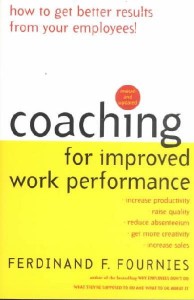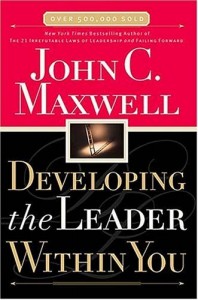Leadership and Learning: Part 2
- On 12-03-2010
In last week’s blog we begun a discussion about developing leadership whilst student’s are learning. This week we explore, what John Maxwell calls “the quickest way to developing leadership“.
F.F. Fourneis, in his wonderful exposition Coaching for Improved Work Performance,  discussed four common reasons why people do not perform the way they should:
discussed four common reasons why people do not perform the way they should:
- They do not know WHAT they are supposed to do
- They do not know HOW to do it
- They do not know WHY they do it
- There are obstacles beyond their control
Despite that this was originally written about work circumstances it is apparent that this can also be said about students in a school situation.
The first two reasons are normally dealt with reasonably well within a classroom environment. We provide excellent explicit teaching on the WHAT and the HOW of doing specific tasks. Having well designed assessment rubrics go a long way to providing students with what they need to show that they have develop knowledge as well as skills and capacities.
Reason three, the WHY, is sometimes not addressed well in classes but can be developed with well designed “tuning in” sessions and linking to the students’ understanding in other areas. A strong WHY will have the students engaged, passionate and enabling strong transference of skills AND knowledge.
Reason four, however, is poorly dealt with by many schools, and in fact most people rarely develop the wherewithal to overcome the obstacles that life throws at them unless their survival is at risk!
[Interestingly, a social psychologist at a conference once shared with me how in a survey he performed of his clients he discovered that 6% changed their unproductive habits from advertising, 17% from an emergency (e.g. heart attack, cancer) while over 70% because a close friend or family member nagged them until they changed!].
One can consider that one major aspect of leadership is the ability to overcome obstacles to achieve the goals you set out to achieve. You look at any successful individual and you will find that they failed many times before they succeeded and what made them successful and leaders in their areas was that they learnt how to overcome or get around obstacles (the youtube video below gives some examples of this).
John C Maxwell in his book Developing the Leader Within You suggests that there are only two things that allow for powerful problem solving and leadership: the right attitude and the right action plan.
Given the importance of attitude to being a leader, next weeks blog will go in depth about the right attitude. At this point I just want you to consider that in a content focussed curriculum and school environment the right attitude of students is to give what the teachers want and what the assessments ask for that will give them the best marks. This does not naturally develop leadership.
With respect to the right action plan John Maxwell outlined the following process to develop the problem solving approach that will give people the ability to tackle the obstacles they face
- Identify the problem – quite often we attack the symptoms not the cause. Identify the real issues that lie beneath the symptoms
- Prioritise the problem – quite often we become stopped because we seem to have too many problems or things to deal with. Being able to list the issues and them prioritise them will allow students to grapple with the reality of the situation and learn how to deal with what is most important first
- Define the problem – defining what is the problem you will tackle (e.g. a critical question the students will tackle in an inquiry learning project) gives direction to the solution process. Maxwell discusses 4 steps to this aspect
- Ask the right questions
- Talk to the right people
- Get the hard facts
- Get involved in the process
- Select people to help you in the process – I have observed that many people try to solve problems on their own and get stuck. What I have found is that the answers always lie in community. Consulting as widely as possible will allow for solutions that you, as an individual, have never thought of.
- Collect problem causes
- Collect possible solutions
- Prioritise and select the best solutions
- Implement the best solution
- Reflect on and Evaluate the solution
You have probably noticed by now that this process IS the process of project-based inquiry learning. Pure inquiry learning, where the students choose a critical question to research and then go about in a discovery approach to answer their question, requires the skills and capacities I have just outlined.
What I ask you to reflect on is … how are you developing your students in the above process EXPLICITLY? Do you have rubrics that the students fill out to train them? Do you have particular practices you use in the class to do this? Do you have specific templates where the students can ritualise this process?
Feel free to comment on the blog!
Next week .. developing the right attitude!

0 Comments